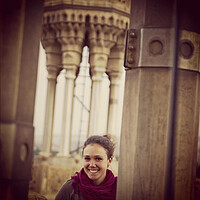In grieving Kenyan town, joy and fear at Easter church services
Loading...
| Garissa, Kenya
“We have to sing this song with a happy voice,” Rev. George Owino urged the dozen or so worshippers gathered for Easter service, just days after Al Shabab militants killed 147 people, mostly Christians, on a university campus here.
The congregation raised their voices as they sang, “Oh happy day, when Jesus washed our sins away…”
But when Rev. Owino stood up in his crisp white robe before the mostly empty pews and spoke about the Christian students gunned down in the dining hall, where they had gathered for morning prayers, his voice and composure broke.
“Many Christians have been asking me a lot of hard questions,” he said, speaking haltingly. “Father, why did our brothers have to go through what they went through?” Some in the pews sniffled.
Garissa’s Christians, outsiders in this predominantly Somali region of Kenya, had long steeled themselves against the danger posed by Al Shabab, the Somalia-based militant group. But Thursday’s attack, in which several gunmen laid siege to Garissa University College and singled out Christians for execution, has left them reeling. They fear a church could be the group’s next target, so many are staying away.
The early morning service at St. Peter’s Anglican Church usually attracts 60 to 70 people. Only 14 attended today. A more popular 9 a.m. service was better attended: about 75 showed up, compared to the usual 200 or so. The rest, says Owino, stayed home out of fear. All day on Good Friday, he received text messages of encouragement from those who were too scared to come.
“I thank the hand of God that they were there,” he says, referring to the 75 who showed. “Now it is about being brave and bold to defend who they believe in.”
St. Peter's is down a quiet side street off Garissa’s main road, which is named for the Somali port of Kismaiyo, a reminder of its proximity to Kenya’s war-ravaged neighbor. Only a widely spaced metal gate keeps out intruders. Since 2012, it has been backed up with two private security guards and four police officers.
But the gate itself was unmanned today, the security guard sitting further back in the compound. She says sitting at the gate makes it too easy to shoot her.
Churches as targets for militants
Up the road, the town’s Roman Catholic church is far more bustling. Behind the walls, once you clear the soldiers searching every person and car, the pews were almost full for Easter service. Al Shabab attacked the church in 2012; security has been tight since then, congregants say. They don’t feel much safer, despite the six police officers and several soldiers posted around the property, but still they come to worship.
Morris Okelo, an electrical contractor originally from western Kenya, clutches his squirming son’s hand as he recalls being at the gate of the church compound when a grenade was lobbed in the 2012 attack. His children were already inside. No one was killed, but there were deaths at another church in town attacked that day.
“Since the last attack, it has not been easy to feel safe,” he says.
Yet until this week, relative calm had prevailed here, even as Al Shabab stepped up its murderous campaign across northeast Kenya.
Today, many milled around in the courtyard of the Catholic church and the service quickly turned joyous. Women ululated as they swayed to the Swahili hymns, children bouncing on their hips.
But many Christians here say that after this week’s attack they wish they could leave the area and move to a safer part of Kenya, if only they could find jobs there.
Owino, the Anglican church leader, says he’s grown weary after spending eight years in the region, three in Garissa. He used to feel the calling always, even when bullets hit his home in Mandera, a restless town near the Somali border. But he is beginning to have doubts, even as he searches for the inner strength to continue his work as a churchman.
“I was struggling to accept what happened,” he says, speaking after the service about what brought him to tears at the pulpit. “As humans, we get emotional, [thinking] God, you are unjust. Where were you? How could you not protect [them]?”
“The fire is catching up,” he says.
This story was reported with support from the Ford Foundation.






